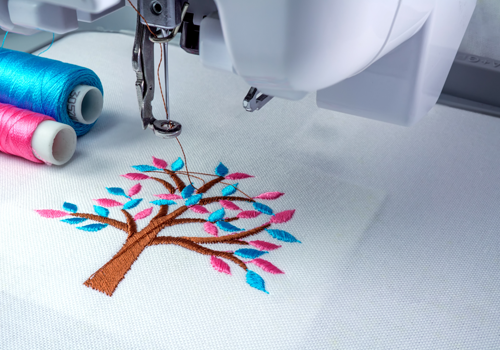
Embroidery is the art of decorating fabric or other materials with needle and thread or yarn. It has been practiced for years. The origin of this art dates back to Cro-Magnon days or 30,000 BC. The fossilized remains of heavily hand-stitched and decorated clothing, boots and a hat were found during a recent archaeological find. In around 5000 and 6000 B.C, elaborately drilled shells stitched with decorative designs onto animal hides were discovered in the region of Siberia.
Chinese thread embroidery dates back to 3500 B.C. where pictures depict embroidery of clothing with precious stones, silk thread and pearls. Paintings, sculptures and recorded history show inhabitants of various ancient civilizations wearing thread-embroidered clothing.
During the 1100's, smaller seed pearls were sewn on parchments to decorate religious items and from the 1200's through 1300's, beads were embroidered onto clothing. By 1500 A.D., embroideries had turned lavish in Europe, as well as other parts of the world. From this period through the 1700's, elaborate thread and bead embroidery became popular. Bead embroidery was seen on home furnishings, layette baskets, court dress and many other items.
Elaborately embroidered clothing, religious objects, and household items was a symbol of money and status in several cultures like Ancient Persia, Japan, Byzantium, India, China and medieval and Baroque Europe. Traditional folk techniques were passed on in cultures as diverse as Northern Vietnam, Mexico and Eastern Europe. Professional workshops and guilds arose in medieval England, which made Opus Anglicanum or "English work," popular across Europe. In the latter half of the 19th century, machine-made embroideries in St. Gallen in Eastern Switzerland flourished. Elaborate freehand stitched thread embroidery declined in popularity with the machine age of the 1800's. Bead embroidery gained popularity alongwith the new needlework stitches of the 1800's.
These days, embroidery thread is manufactured in cotton, rayon and novelty yarns as well as in traditional wool, linen and silk. There is also something known as ribbon embroidery that uses narrow ribbon in silk or silk blend ribbon to create floral motifs. A lot of fashion designers feature richly embroidered clothing in their collections.
Embroidery has really come a long way. Hope you liked reading about its journey!